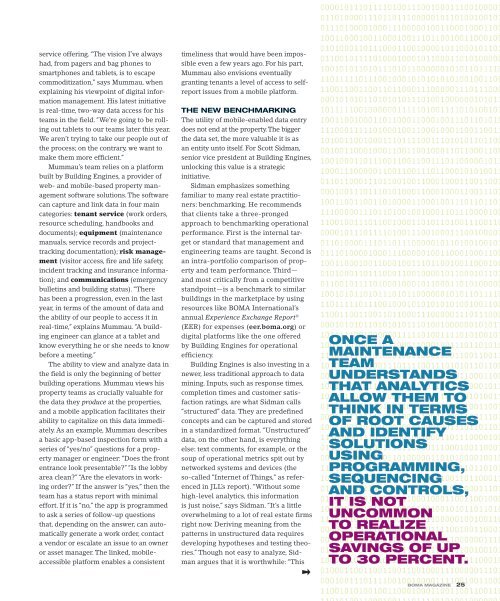Create successful ePaper yourself
Turn your PDF publications into a flip-book with our unique Google optimized e-Paper software.
service offering. “The vision I’ve always<br />
had, from pagers and bag phones to<br />
smartphones and tablets, is to escape<br />
commoditization,” says Mummau, when<br />
explaining his viewpoint of digital information<br />
management. His latest initiative<br />
is real-time, two-way data access for his<br />
teams in the field. “We’re going to be rolling<br />
out tablets to our teams later this year.<br />
We aren’t trying to take our people out of<br />
the process; on the contrary, we want to<br />
make them more efficient.”<br />
Mummau’s team relies on a platform<br />
built by Building Engines, a provider of<br />
web- and mobile-based property management<br />
software solutions. The software<br />
can capture and link data in four main<br />
categories: tenant service (work orders,<br />
resource scheduling, handbooks and<br />
documents); equipment (maintenance<br />
manuals, service records and projecttracking<br />
documentation); risk management<br />
(visitor access, fire and life safety,<br />
incident tracking and insurance information);<br />
and communications (emergency<br />
bulletins and building status). “There<br />
has been a progression, even in the last<br />
year, in terms of the amount of data and<br />
the ability of our people to access it in<br />
real-time,” explains Mummau. “A building<br />
engineer can glance at a tablet and<br />
know everything he or she needs to know<br />
before a meeting.”<br />
The ability to view and analyze data in<br />
the field is only the beginning of better<br />
building operations. Mummau views his<br />
property teams as crucially valuable for<br />
the data they produce at the properties,<br />
and a mobile application facilitates their<br />
ability to capitalize on this data immediately.<br />
As an example, Mummau describes<br />
a basic app-based inspection form with a<br />
series of “yes/no” questions for a property<br />
manager or engineer: “Does the front<br />
entrance look presentable” “Is the lobby<br />
area clean” “Are the elevators in working<br />
order” If the answer is “yes,” then the<br />
team has a status report with minimal<br />
effort. If it is “no,” the app is programmed<br />
to ask a series of follow-up questions<br />
that, depending on the answer, can automatically<br />
generate a work order, contact<br />
a vendor or escalate an issue to an owner<br />
or asset manager. The linked, mobileaccessible<br />
platform enables a consistent<br />
timeliness that would have been impossible<br />
even a few years ago. For his part,<br />
Mummau also envisions eventually<br />
granting tenants a level of access to selfreport<br />
issues from a mobile platform.<br />
THE NEW BENCHMARKING<br />
The utility of mobile-enabled data entry<br />
does not end at the property. The bigger<br />
the data set, the more valuable it is as<br />
an entity unto itself. For Scott Sidman,<br />
senior vice president at Building Engines,<br />
unlocking this value is a strategic<br />
initiative.<br />
Sidman emphasizes something<br />
familiar to many real estate practitioners:<br />
benchmarking. He recommends<br />
that clients take a three-pronged<br />
approach to benchmarking operational<br />
performance. First is the internal target<br />
or standard that management and<br />
engineering teams are taught. Second is<br />
an intra-portfolio comparison of property<br />
and team performance. Third—<br />
and most critically from a competitive<br />
standpoint—is a benchmark to similar<br />
buildings in the marketplace by using<br />
resources like BOMA International’s<br />
annual Experience Exchange Report®<br />
(EER) for expenses (eer.boma.org) or<br />
digital platforms like the one offered<br />
by Building Engines for operational<br />
efficiency.<br />
Building Engines is also investing in a<br />
newer, less traditional approach to data<br />
mining. Inputs, such as response times,<br />
completion times and customer satisfaction<br />
ratings, are what Sidman calls<br />
“structured” data. They are predefined<br />
concepts and can be captured and stored<br />
in a standardized format. “Unstructured”<br />
data, on the other hand, is everything<br />
else: text comments, for example, or the<br />
soup of operational metrics spit out by<br />
networked systems and devices (the<br />
so-called “Internet of Things,” as referenced<br />
in JLL’s report). “Without some<br />
high-level analytics, this information<br />
is just noise,” says Sidman. “It’s a little<br />
overwhelming to a lot of real estate firms<br />
right now. Deriving meaning from the<br />
patterns in unstructured data requires<br />
developing hypotheses and testing theories.”<br />
Though not easy to analyze, Sidman<br />
argues that it is worthwhile: “This<br />
ONCE A<br />
MAINTENANCE<br />
TEAM<br />
UNDERSTANDS<br />
THAT ANALYTICS<br />
ALLOW THEM TO<br />
THINK IN TERMS<br />
OF ROOT CAUSES<br />
AND IDENTIFY<br />
SOLUTIONS<br />
USING<br />
PROGRAMMING,<br />
SEQUENCING<br />
AND CONTROLS,<br />
IT IS NOT<br />
UNCOMMON<br />
TO REALIZE<br />
OPERATIONAL<br />
SAVINGS OF UP<br />
TO 30 PERCENT.<br />
BOMA MAGAZINE 25


